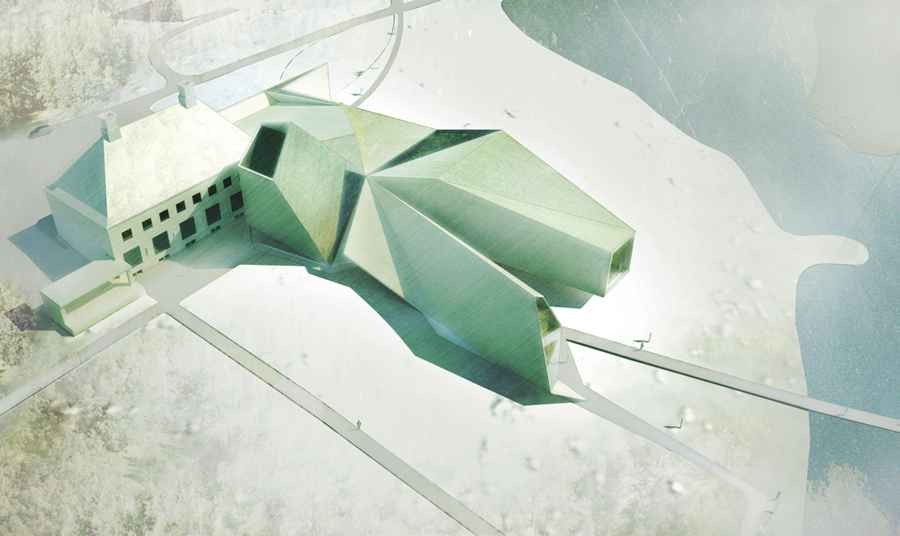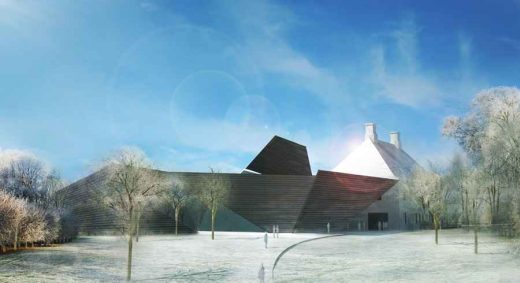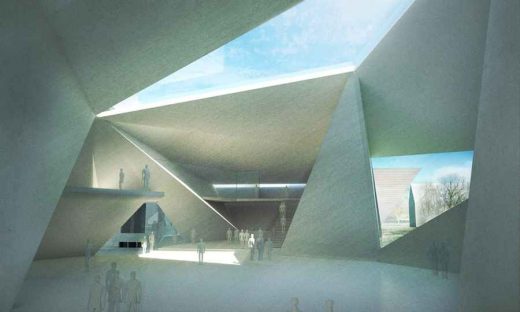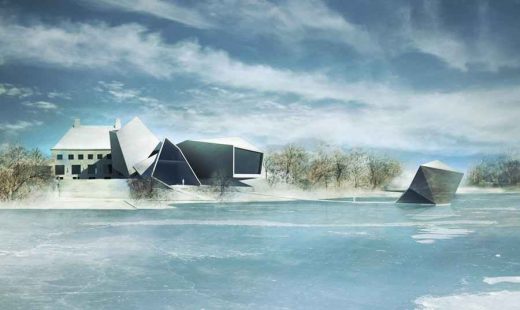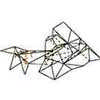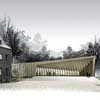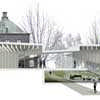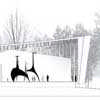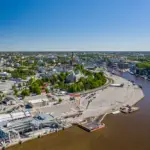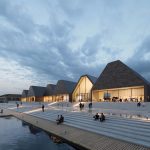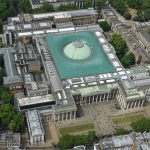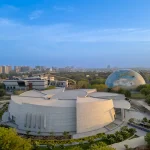Gösta Contemporary Art Museum, Finnish Design Contest, Contemporary Building Finland
Gösta Contemporary Art Museum : Design Contest Finland
Finnish Contemporary Art Museum, Mänttä design by various architects
16 Jan 2012
Design: Matteo Cainer Architects Ltd
Taittogami_ Gösta Serlachius Museum, Finland
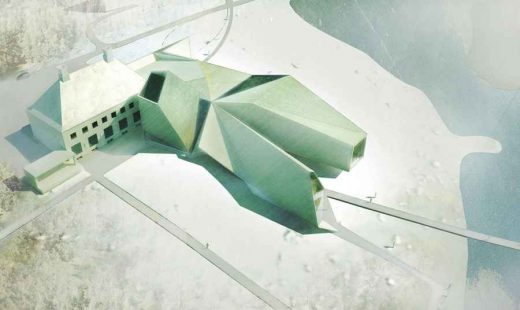
images : Matteo Cainer Architects Ltd
Gösta Serlachius Museum
The project for the expansion of the Gösta Serlachius Museum, presents an opportunity to explore a creative relationship between the existing museum and the surrounding landscape. Through a new and distinctive poetic architectural language, the project develops a harmonious ensemble that blurs the boundaries between existing and new.
The proposed extension will allow the museum to develop a unique cultural environment, integrating the aesthetic, functional, and economic goals of a larger and more varied institution through an extended programme of activities.
Importantly, it will introduce a new informality through a series of fluid volumes that establish an exciting relationship between the house, the existing grounds and the landscape beyond. The project will provides an entrance and orientation space, the “heart” of the extended museum, which will lead to a series of dramatically lit flexible spaces for exhibitions, conferences, educational activities and other public events.
Gösta Serlachius’ extensive business interests in wood and paper processing supported his life-long passion and support of the arts; it is therefore through a reinterpretation of these two elements that the proposed extension expresses the pivotal role and influence of the Serlachius family. The form of the Serlachius house, especially the roof, is the template for the new building.
The geometry of the roof planes are folded and cut in the manner of paper ori-gami “folding-paper” and kirigami “folded and cut shapes”, to develop a complex sequence of architectural spaces that slowly unfold to create a new layered experience. As in origami, the number of basic folds is small, but the evolving geometry results in a series of intricate shapes of surprising complexity. The nature of these is far removed from the walls and roof elements of a traditional building.
Timber is the language of the proposed extension, not only as an expression in the Nordic tradition, but representing the bold angular beauty that defines the landscape, where invisible forces can theatricality shape both the interior and exterior. The structure and building envelope are expressed as a single component that can be manufactured from a variety of wood products to meet the geometrical tolerances of the structure and the capacity for snow loads.
This integrated approach results in day lit column-free spaces that express a variety of unusual forms and volumes internally. Clad in bitumen-coated weatherboarding, the extension is punctuated by a series of external glazed fins that allow controlled daylight to illuminate internal surfaces, generating surprising and inspiring effects that changes through the seasons.
Selected views of the landscape, the island and the lake are framed through openings in the new restaurant. Interpreting the transition from land to water, the architecture will respond to each season through elements that transform to create new spaces. In the summer months the lakeshore deck is used for water-side activities.
In the winter, it transforms into a transitional space for the sauna strategically placed in the lake.The museum will nourish the mind and the body, providing stimulation for the intellectually curious and those seeking tranquillity or recreation.
As in the complex folds of origami there is a rare and underlying simplicity as the interior of the museum unfolds as a sequence of programmatic spaces. The resulting architecture generates therefore, a new sequentially linked space where the visitor will experience an unexpected dialogue between the new museum and the surrounding scenery.
Gösta Serlachius Museum Finland – Building Information
Credits: Matteo Cainer Architects Ltd
Location: Mänttä, Finland
Use: Museum Extension
Client: Gösta Serlachius Fine Arts Foundation
Total floor area: 4,760 sqm
Gösta Serlachius Museum images / information from Matteo Cainer Architects
27 Jul 2011
Gösta Contemporary Art Museum
architectural studio MX SI
The architectural studio MX_SI based in Barcelona, is the winner of the competition for the extension of the Gösta contemporary Art Museum in Finland
579 entries, the largest competition in Finnish history
MX_SI architectural studio based in Barcelona, wihich are the authors for the Federico Garcia Lorca Cultural Center in Granada, will build the extension of the Museum Gösta for Contemporary Art in Mänttä. This competition has been the largest architectural tender in Finish history with 579 participants from 42 countries.
This international open competition was organised by the Serlachius Foundation supported by the Architecture Chamber of Finland SAFA, to extend the main building that originally was not planned as a museum. This new building, Serlachius Foundation will adequate their facilities in order to host large scale contemporary art travelling exhibitions as well as defining an appropriate space for their own collection.
The jury was integrated by musem experts and professional finish architects. It was unanimously decided last 22nd of June, to give the first prize to the project presented by Mara Partida, Boris Bezan and Héctor Mendoza. According to jury’s statements, the architecture solution proposed a fine understanding on existing features such as main building, site landscape and finish traditional and contemporary culture. The jury outstands the respect that new construction has with the place, without losing own up-to-date architecture expression.
Some other values read by the jury are the harmony of new volume with landscape. It is an integrated body taking a clever advantage of the use of wood as a main façade material. Interior spaces develop a dialogue with the exterior enriching the expressive journey.
Construction work on the extension will begin in early 2012 and the new spaces will be opened to the public in spring 2014.
The Project
The site is understood as a green plateau where the manor’s monolithic figure stands imposingly along a landscape axis, sloping gently to the banks of Lake Melasjärvi.
The strategy consists in placing the building out of the zone in between the manor, the plateau-park and the Taavetinsaari island, in mimicking the new building within the forest, and finally in respecting the recently renovated park, as well as the formal garden design.
The new premises are located in parallel to the access, manor and garden axis, on the west side of the principal axis. It uses the parameters of topography and distance to accommodate the program. In this sense the Joenniemi Manor keeps being the dominant built structure of the area.
The location of the new entrance reinforces the existing spacious access yard as access plaza of the whole intervention.
The outside spatial quality is brought inside the new building. The heart of the building – foyer and restaurant – have the best view towards the lake and the island similar to the existing house main areas.
The simple horizontal body of the extension building gathers all main areas in one great plateau: entrance, foyer, connection and exhibitions which facilitates visitors’ orientation. The new building is organized by a spacious foyer, placed at the same level of the ground floor of the manor. This space obtains visual continuity between outside and inside by introducing incisions of landscape to the main building body.
To allow flexibility of exhibitions layout, the structure of the building is part of the facade liberating the whole space. All walls in the exhibition zone can be used for exposing.
The project as a densified abstract forest. The forest in the placement where the new building will be constructed is conceptually transformed in an abstract way of parallel frames. In one hand they define the overall geometry of the new building, but at the same time they also allow transversal permeability. The result is that the parallel pattern of the structural frames is maintained from outside and inside structuring the whole building. The use of wood is a reference to the local industry’s history.
The studio
MX_SI is an experimental studio of architecture, a quartet of young Mexican and Slovenian architects based in Barcelona. The studio was founded in 2005, upon receiving the first prize for the construction of “The Centre Federico García Lorca’’ in Granada – their first work together.
Since then, work has been focused primarily on developing public competitions either Cultural or historic City Centers. Gradually, its creative activity has been consolidated by winning numerous prizes in national and international competitions like Europan 8 in Goteborg Sweden 2006, Auditorium in Lucena Córdoba 2006, ROG art center in Ljubljana 2008, and the “AJAC prize” for young architects in Catalunya 2010.
The partners had previously worked together or separately with renowned international architects, developing important projects in different countries of Europe and America.
MX_SI is moved on the basis of continuously exploring architectural essence as a logical and comprehensive dialogue among structure, geometry, and context, spatial and visual expression. Their work is branded by its versatility in solving complex programmes understanding user needs, context and materiality as a whole. This concern shows a significant sensitivity to time, in order to integrate the new with the already existing, highlighting the plastic qualities of their projects and the environment.
Gösta Contemporary Art Museum Finland – Building Information
Architects: Marta Partida, Boris Bezan, Hector Mendoza
Collaborators: Oscar Espinosa, Olga Bombač
Cliente: Serlachius Foundation
Built surface: 4.500 m2 aprox.
Gösta Contemporary Art Museum images / information from MX_SI
15 November 2022
Art Sauna, Gösta Serlachius Museum Of Contemporary Art
Design: Mendoza Partida + BAX Studio
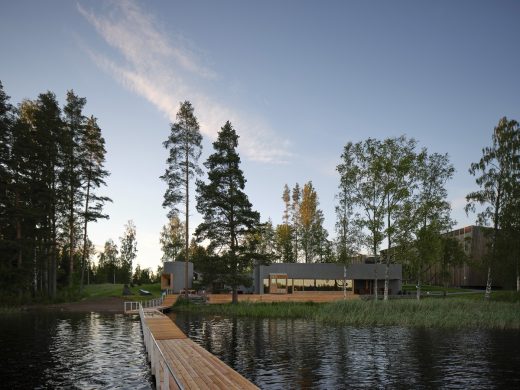
photo © Marc Goodwin
Art Sauna, Gösta Serlachius Museum
Location: Mänttä, Finland
New Finnish Architecture
Contemporary Architecture in Finland
Finnish Architecture – Selection
House Moby Dick, Espoo
Arkkitehdit NRT
House Moby Dick
Kamppi chapel of silence, Helsinki
K2S Architects
Kamppi Chapel
Kuokkala Church, Jyväskylä
Lassila Hirvilammi Architects
Kuokkala Church
Hanko Ice Cream Kiosk, Helsinki
Wood program 2007: Satoshi Ohtaki + working group
Hanko Ice Cream Kiosk
Comments / photos for the Gösta Contemporary Art Museum – Mänttä Building design by various architects page welcome

